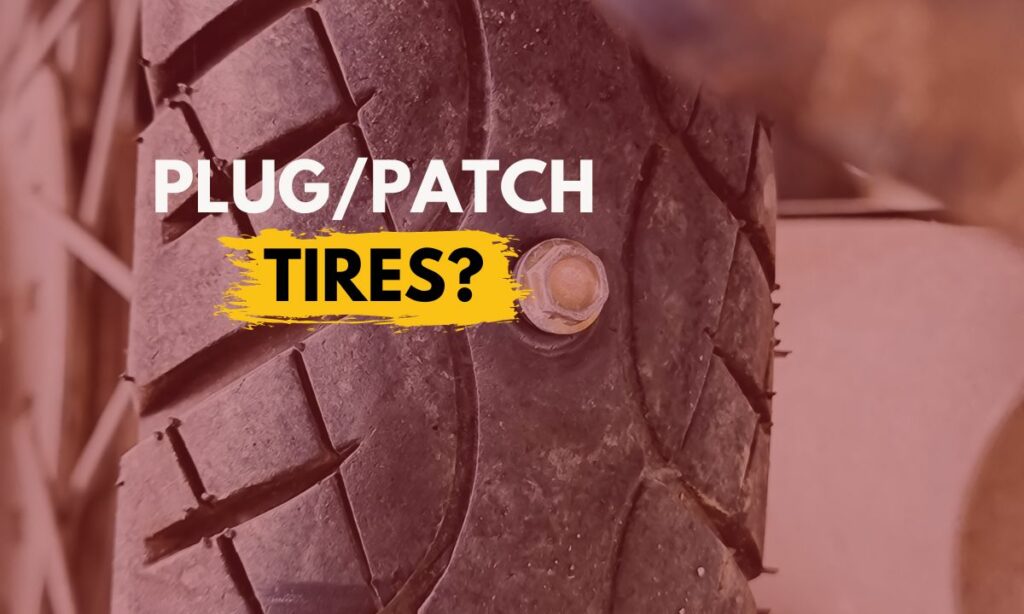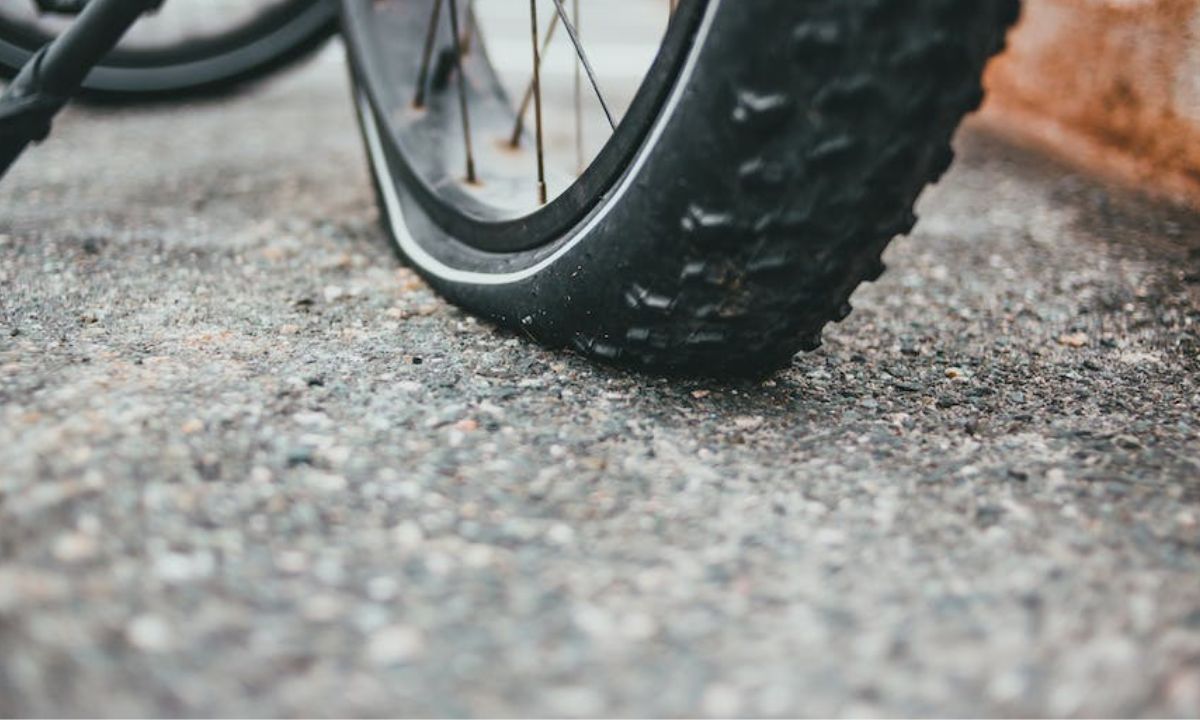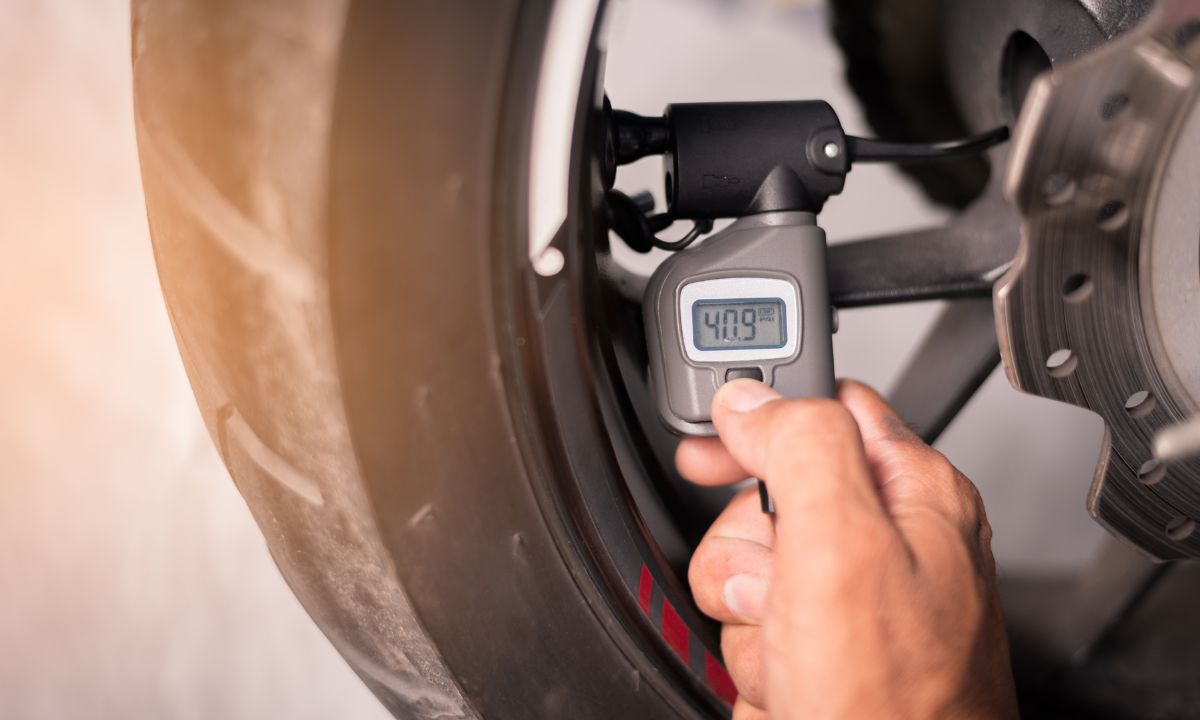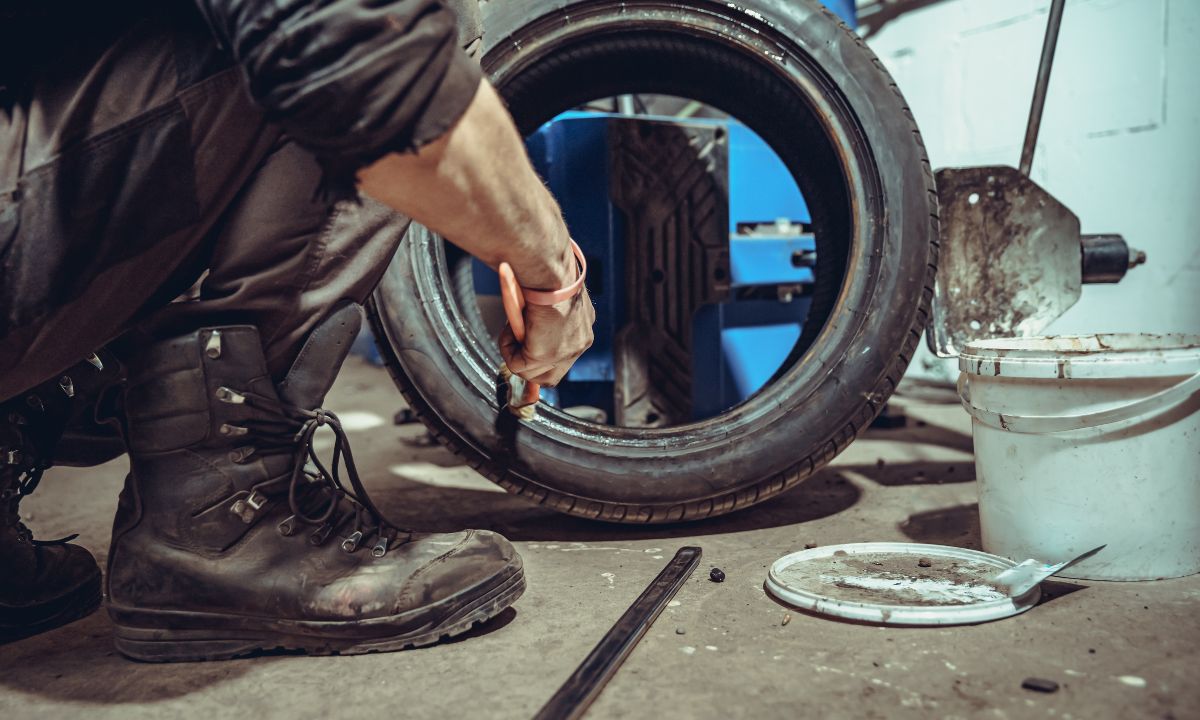A small nail can have a large impact.
Ask your motorcycle tire when punctured by a nail. It hurts really bad if the tire is still new.
With a punctured hole on the tire, we always wonder whether or not to plug or patch the tire.
So, can you plug or patch a motorcycle tire?
If the puncture is on the tire sidewall or the puncture hole is large (more than 7mm in diameter) – you cannot plug or patch the tire.
But, if the puncture is small and is on the tire tread, then it is possible to plug or patch the tire.
Most service shops won’t patch tires because they will be liable if things go wrong because of that patched tire.
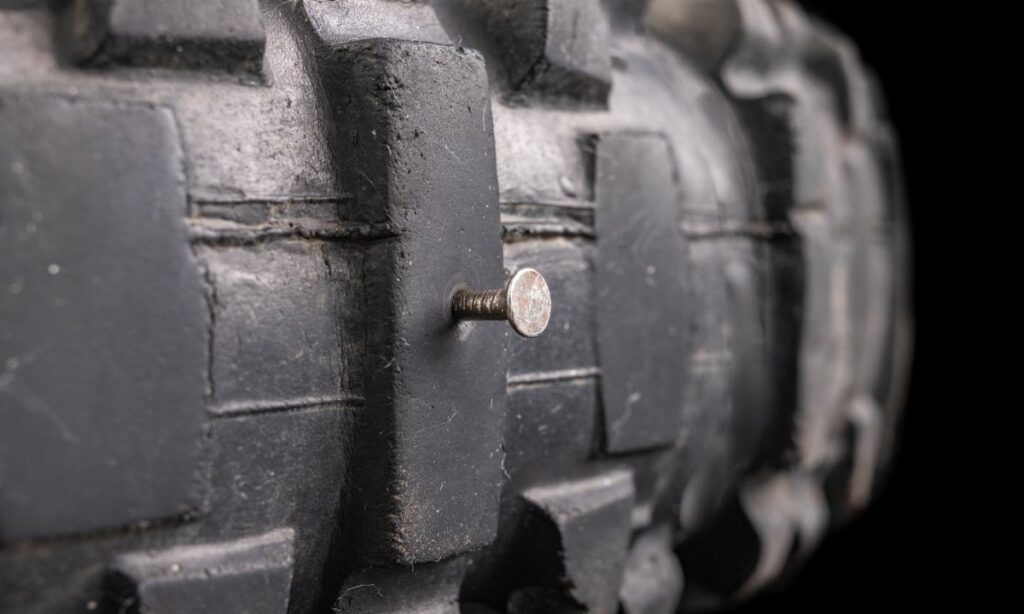
Shops also make more money by selling new tires rather than patching them. So, there is that incentive as well.
Usually, if the patch fails, the loss in pressure will take some time. Giving the rider a minute or two to feel the flat tire and pull over.
Still, it is better to be safe than sorry.
You don’t want to pay huge medical bills just because you want to save a few bucks on a new tire.
This is the summarised version you came for.
For a more detailed version covering all the nuances, let’s dive right in.
Can a Motorcycle Tire be Plugged or Patched?
If the puncture is on the tire sidewall or the puncture hole is large, say more than 7mm in diameter, you cannot plug or patch the tire.

If on the other hand, the puncture is small and on the tire tread, then it is possible to plug or patch a tire.
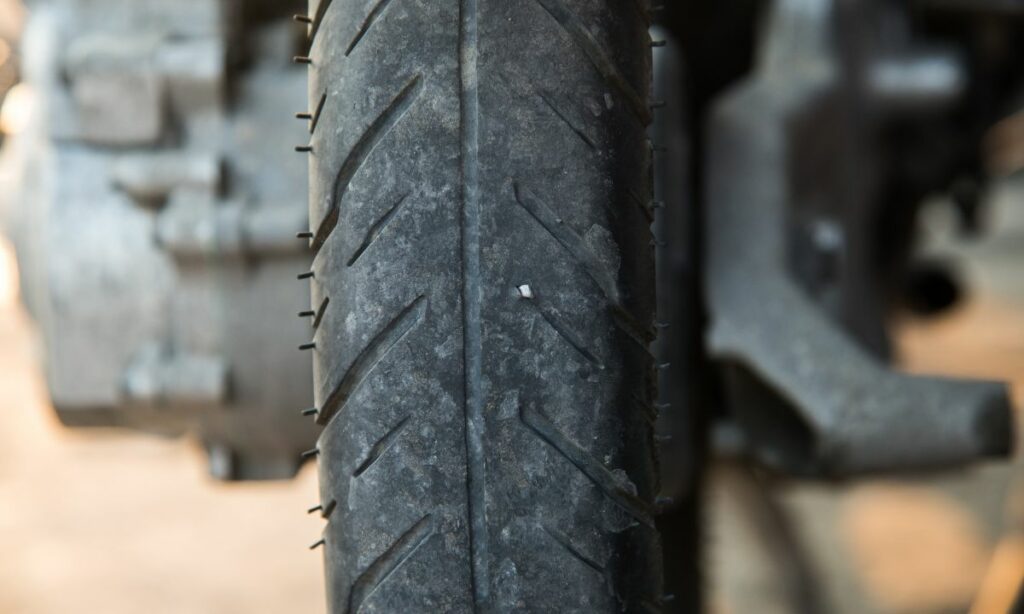
Patches are used for the inner tubes of the tires.
For tubeless tires, you don’t patch but use plugs on the tubeless tire.
Put simply:
Plugging is for tubeless tires.
Patching is for tube tires.
It is very common to plug the motorcycle tire, be it a skinny tire or a wide tire, whenever a nail is picked up.
Although wide tires are much easier to plug.
Is it safe to plug/patch a motorcycle tire?
You can technically plug or patch a motorcycle tire if the blowout is small and is on the tire tread.
But is it safe though?
Almost all dealers don’t recommend plugging or patching a tire.
But many riders do plug/patch their tires after a blowout.
Personally, I think it’s safe to patch or plug the tire as long as the puncture hole is small (less than 5mm diameter) and is on the treads.
Not on the shoulders. Not on the sidewall.
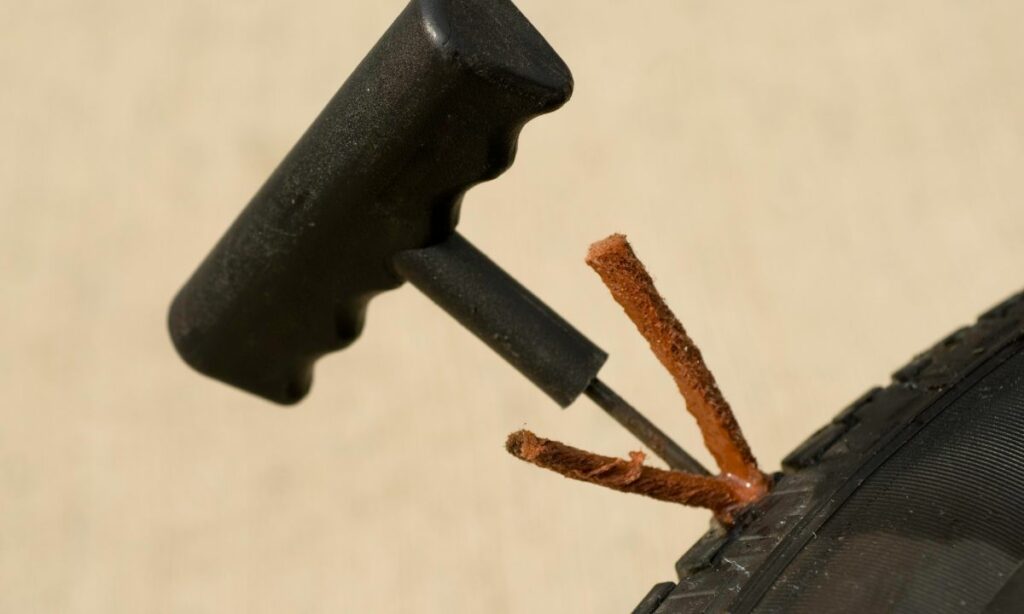
Most of the time, the plugged (or patched) tire won’t even cause a problem.
Not even losing a single PSI for long miles traveled after.
Even if the tire is losing pressure, it will take some time to deflate. The rider can heed the warning. And act on it by halting the motorcycle.
I also think it is best practice to carry a plug kit with you while going for a long ride.
Even if you don’t believe in plugging the tires, you can use the remedy for temporary purposes.
It will help you from being stranded on an empty, isolated road without any shops nearby.
Once you are back from the ride or find a repair shop on your ride, you can opt for replacing the tire.
How long can you ride on a plugged/patched motorcycle tire?
If the punctured hole was really small, you can ride the plugged and patched tire for another 2 to 3 years.
Provided, the tire is not old and worn out already.
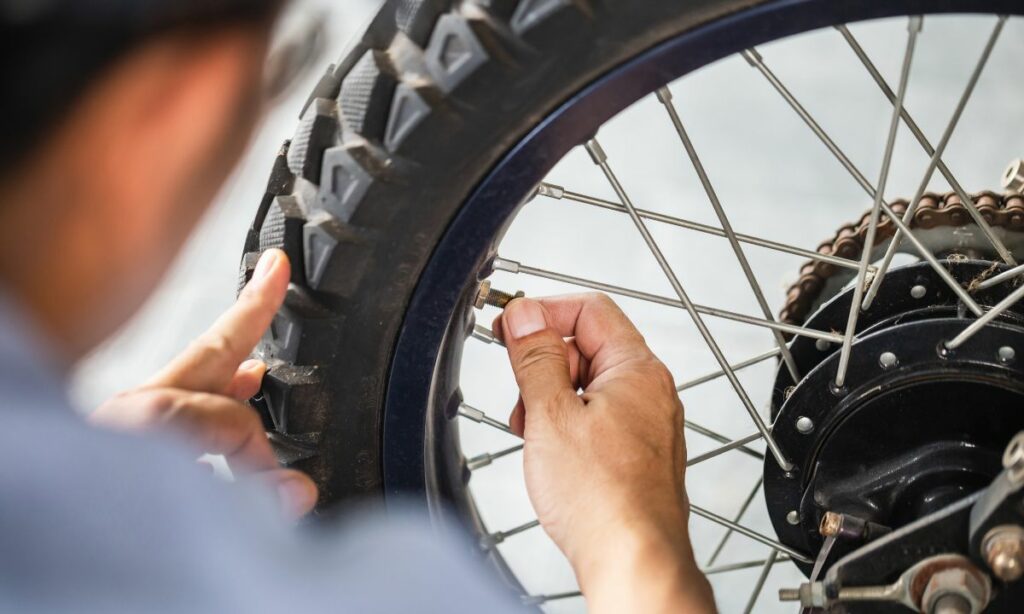
A good and new tire usually has lots of hairs on the tread and the sidewall.
But if the tire is already old, plugging or patching is not the best choice.
You would be better off replacing the tire entirely.
Why do dealers and service shops refuse to plug or patch the tires?
If the inner tube of a tire can be patched and the tubeless tire can be plugged easily, then why do repair shops and dealers refuse to plug or patch them?
There are mainly two reasons why shops won’t plug or patch a motorcycle tire.
- Liability Reasons
- Profitability Reasons
Liability Reasons
Most service shops refuse to plug or patch specifically a motorcycle tire.
This is because, unlike cars, motorcycles have a higher risk of damage in case the plug/patch fails.
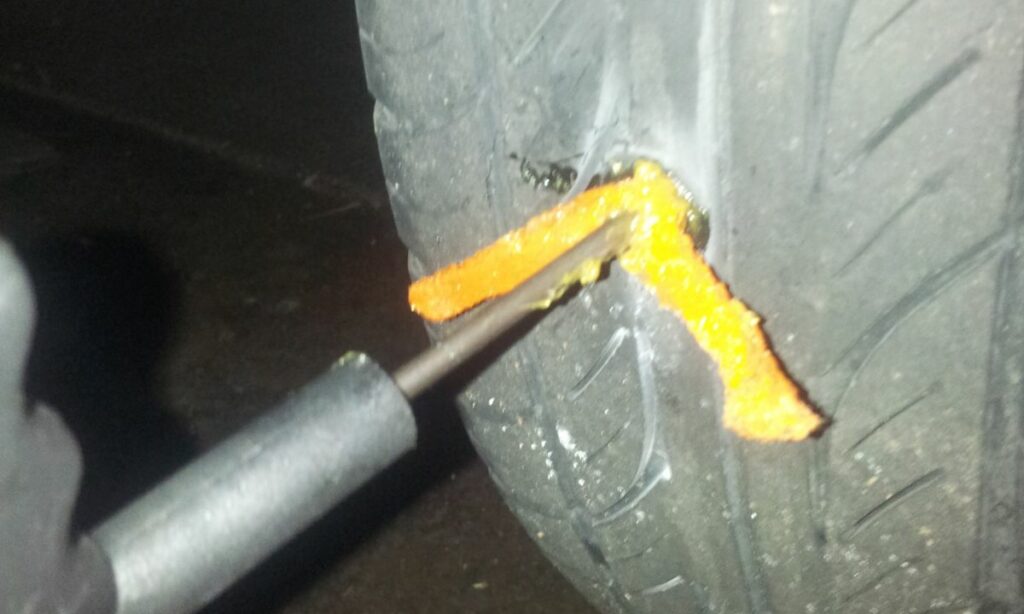
On a car tire, if the patch fails and the pressure leaks off, the car driver will be able to judge the problem easily and halt the car.
Even if the driver didn’t, the worst case would be a flat tire without any accident.
However, with motorcycle tires, the situation is much riskier.
If the patch or the plug fails down disastrously, things might not end well for the motorcycle rider.
If the rider was driving at a high speed or at a turn when the tire blows out, the situation might result in some serious injuries to the rider or worse, death.
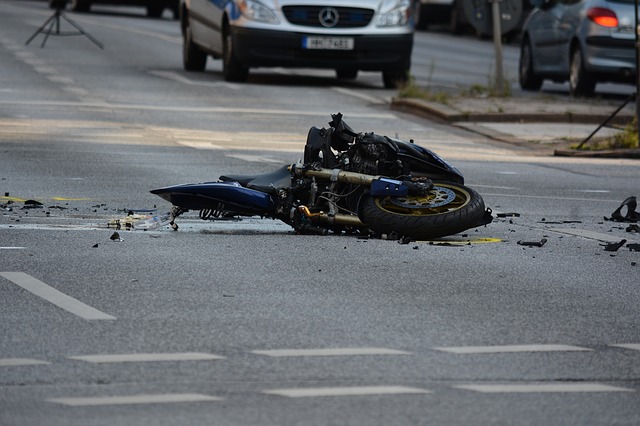
And this is a liability concern for the service shops.
If the patch or plug fails and turns out to be the reason for the damage, the service centers will be in serious trouble.
They might be sued for the damage caused just because they agreed to patch up a motorcycle tire.
And that’s why most service shops are unwilling to take the risk. They might be liable for the damage caused in case the patch fails.
Profitability Reasons
Apart from the liability concerns, service centers also have the incentive to refuse patching since selling a new tire brings them more money.
Motorcycle repair shops realize much better profits when they sell you a new tire rather than patching or plugging the tire.
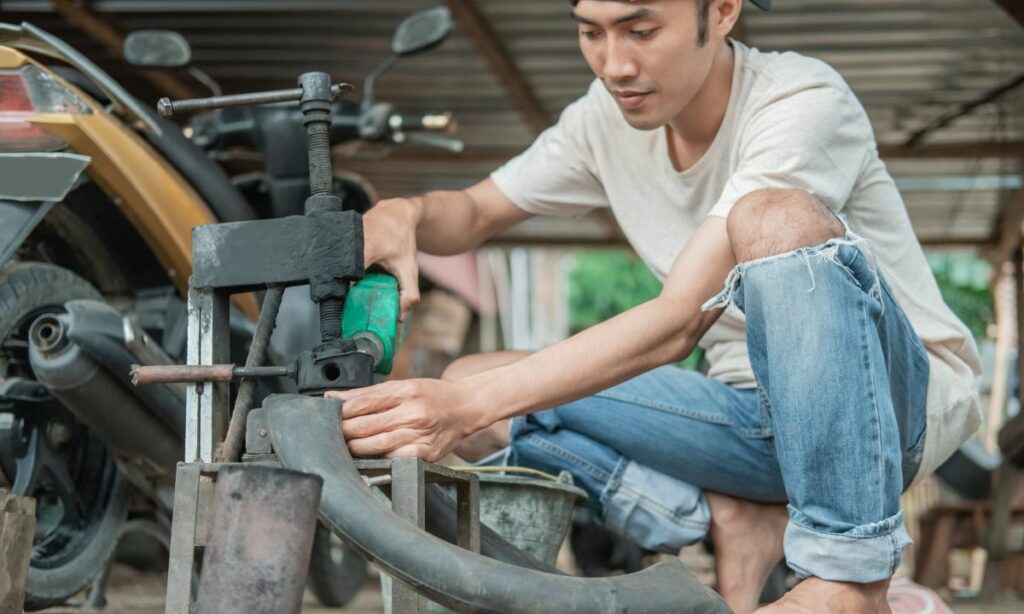
Usually, plugging a tubeless tire or patching the innertube costs around $20 to $25.
Compare this with replacing a tire that is going to cost you around $250.
Which one of the two do you think the motorcycle service center will prefer?
A new tire of course.
So, that’s another reason why service shops insist on replacing with a new tire over plugging or patching.
What do the tire manufacturers say about plugging and patching?
Now, we know retail service shops prefer replacing with a new tire. Whereas many motorcycle riders prefer plugging or patching.
But what do the tire manufacturers say about motorcycle tires getting plugged or patched?
Motorcycle tire manufacturers do NOT recommend plugging or patching the tires.
However, they also admit that it depends on a lot of different variables.
For example, where the nail is located, how large the nail is, how old the tire is, the size of the tire, the design, etc.
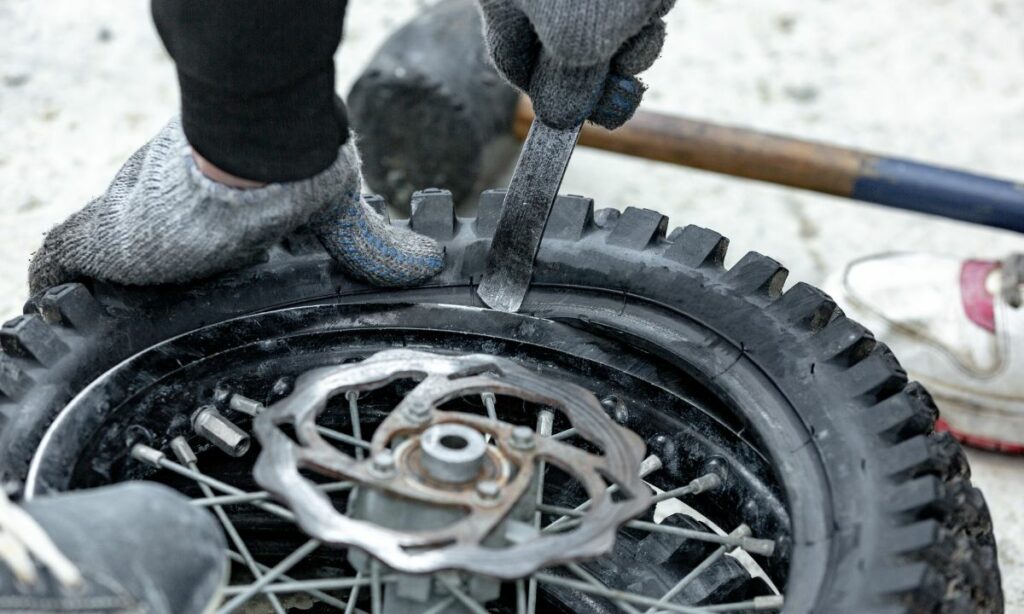
Suppose, the nail is stuck on the sidewall of your motorcycle tire. In that case, it is usually a direct recommendation to replace your tire with a new one. You can’t plug a side wall damage.
On the other hand, if the nail is hitting the face of the tire, the manufacturer’s answer is ‘it depends’.
If it is a small puncture hole on your brand-new tire, you will be tempted to go ahead with plugging.
Even the tire manufacturers do not have a straight answer here.
They still recommend exercising caution here though.
Saving a few hundred bucks is not worth it in exchange for some serious potential accidents is their line of thought.
Why do riders still opt for plugging or patching tires?
So, despite the safety and liability concerns, why do many people still go for having their motorcycle tires plugged or patched?
First, many motorcycle riders feel patching a nail hole on the tread or the face of the tire is no big deal.
They have had a nail hole before, they have patched or plugged the tire, and have never faced any problem whatsoever for years.
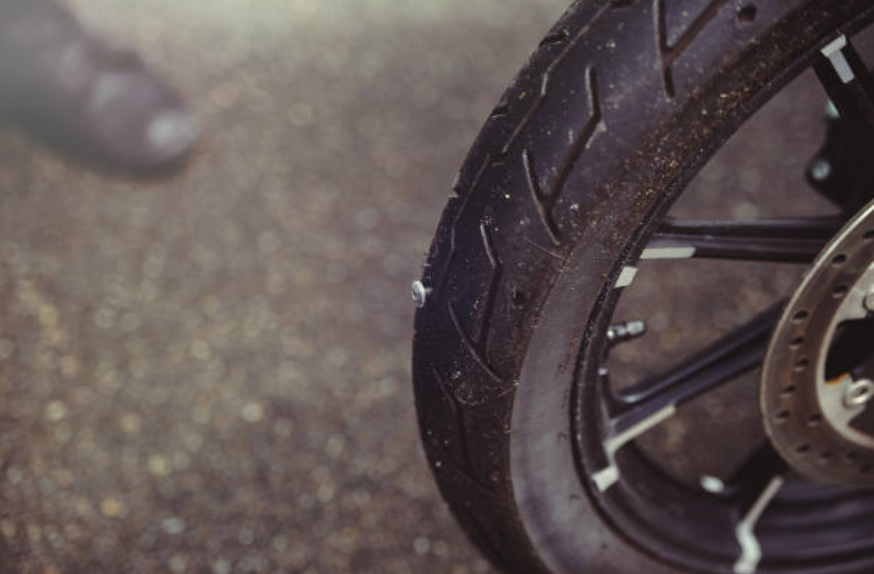
This first-hand personal experience of these motorcycle riders makes a valid argument.
But.
Just because they have not faced any problems does not mean it is universally applicable.
Still, many people go ahead with plugging or patching their motorcycle tires when faced with a nail hole.
Second, another argument that pro-patchers make is even in the worst-case scenario, the rider will have sufficient time to pull over.
That is, even if the motorcycle tire which is patched, blows out – the pressure in the tire will take some time to lose out.
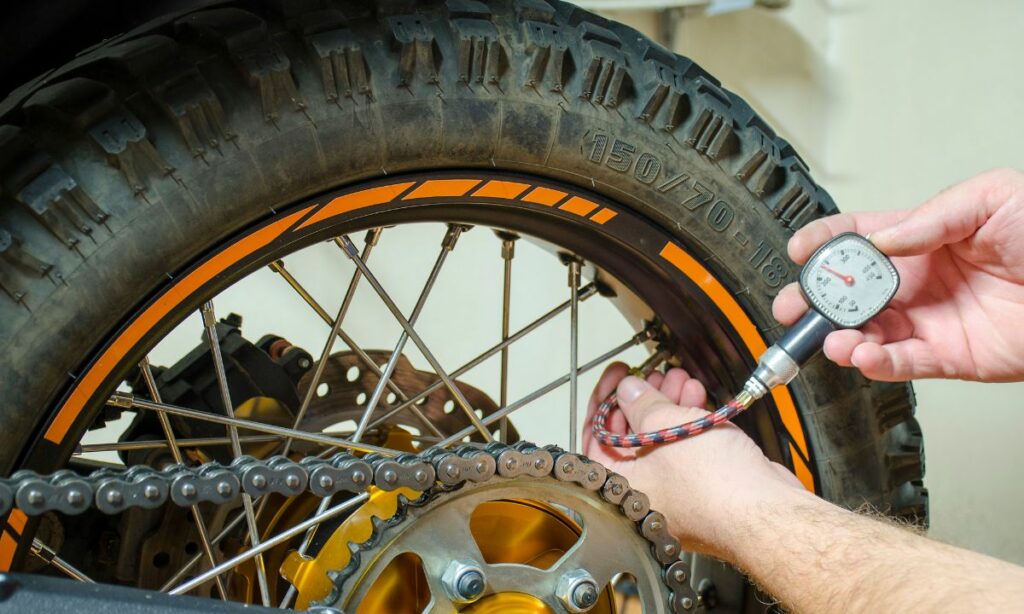
And that should provide sufficient time for the rider to bring the motorcycle to a halt.
While this is a valid argument and tubeless tires do deflate at a much slower rate, tubed tires – on the other hand – deflate fast.
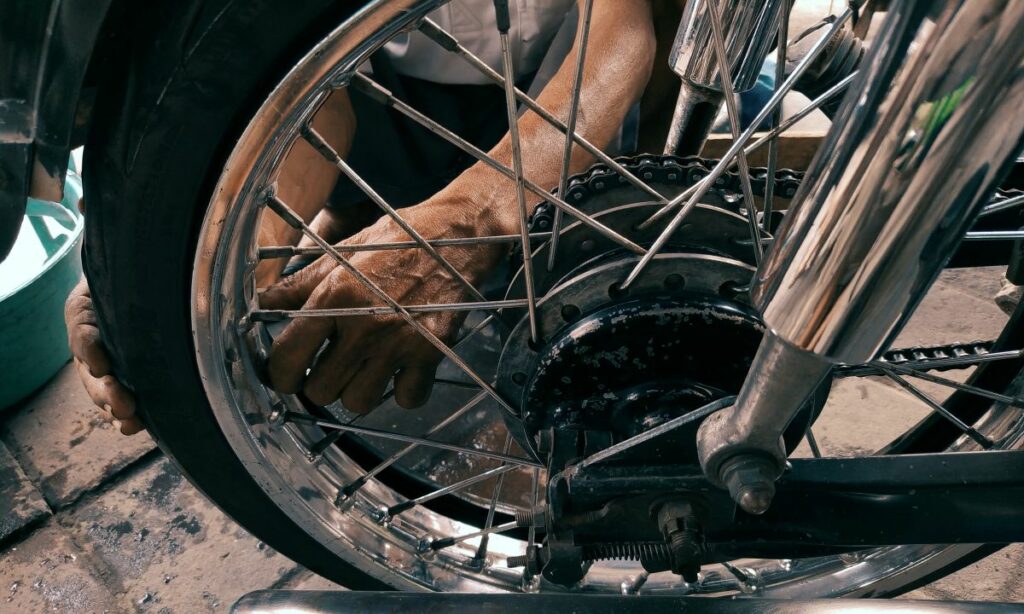
Third, for the rider to face a fatal accident, a lot of things have to work against him/her along with the patched tire failing.
The motorcycle should be going at a high speed, the rider not detecting the loss of pressure in the tire, and then hitting the debris or skid while turning.
All these things working out together is a rare case scenario.
This one is a weak argument.
No matter how small it is, you can’t risk the chance.
And that’s why even if you go ahead with patching or plugging your motorcycle depending on whether it is tubed or tubeless, you should never max out to high speed.
The risk of failing the patch is too high to chance it.
In the end, the decision to plug/patch is yours
Or the service shop guys.
Depends on how much you are reliant on the shop guy.
While most repair shops refuse to patch the nail hole in your motorcycle tire, you can always find some other shop willing to do it for you.
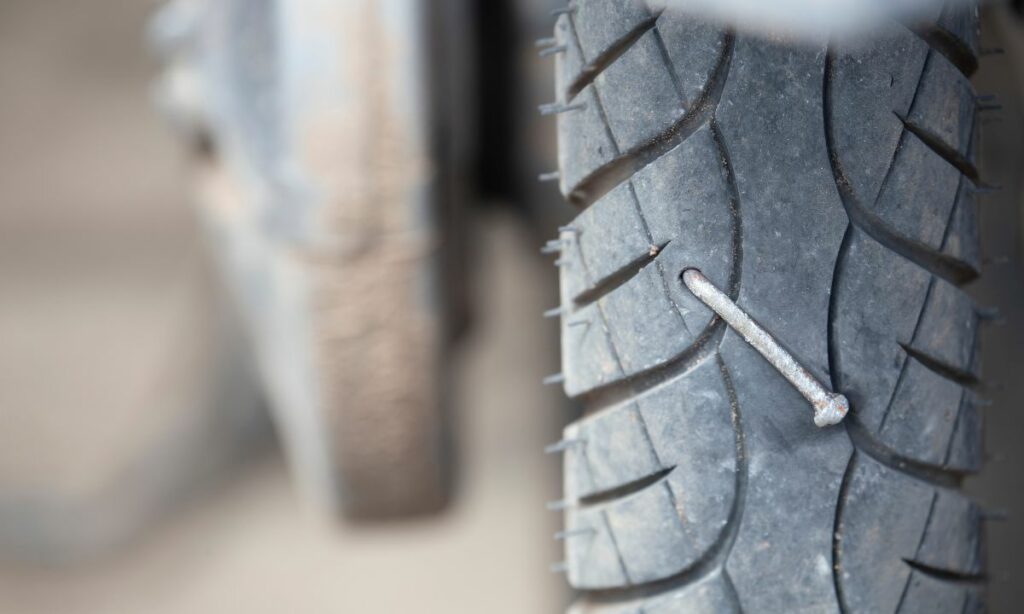
In the event that you cannot find any such motorcycle repair shops, you can always do it yourself using a plug kit.
So, in the end, it boils down to what you prefer.
Going ahead with patching and not splurging your money on a new tire, or deciding to replace it with a new tire to potentially save thousand-dollar medical bills in case the worst scenario plays out – both choices are for you to decide.
In case you want to DIY, here’s how to patch a motorcycle tire
In the event that you decide to go ahead with patching and want to do it yourself, here are the steps you need to follow.

- Check if the flat tire is punctured
Look for a puncture or blowout on the tire surface. If the puncture is not obvious, fill the tube (or tire if tubeless) with air. Dip it in a tub full of water. Watch where bubbles are coming, that’s where the puncture is.
- If there is no puncture, fill the air in the tire
No puncture means the tire has only lost air. Fill the tube (or tire if tubeless) with air to the recommended PSI. Also, check for the valve and rim for possible air leakage.
- If the tire is punctured, you have to patch (plug) it
The next step is plugging or patching the puncture.
Patches are used for the inner tubes of the tires. For tubeless tires, you don’t patch but use plugs on the tubeless tire. - If the puncture is large, the tire is dead
If the puncture is on the sidewall, or the hole is large than 7mm, you just cannot repair it.
- Buff the inner lining
Buff the inner lining of the tire around the holed area. Use a file or sandpaper to accomplish this.
- Patching and plugging
Insert the patch or plug and remove the covering of the patch from the tire. You can apply rubber cement and allow it to dry down for several minutes before removing the covering.
- Check for leakage even after patching
Inspect the Tire now for any leakages. Fill the tire with air and check for air tightness with soapy water.
- Place the tires back
Now, reinstall the tire on the motorcycle and inflate the pressure to the recommended PSI.
- Aftercare
For the next 1 or 2 days limit the maximum speed to 50 mph. Patched tires are a risk. Never exceed 75 mph speed over the lifetime of the patched tire. You don’t want to risk a blowout.
Disclaimer:
Patching and plugging a tire is useful but not as a permanent fix. It is to be seen as an on-the-road quick solution so that you can take it to a proper facility and replace the patched tire with a new one.
Summing Up
Here is the summary of this entire blog post on whether motorcycle tires can be plugged or patched.
- Plugging and Patching a motorcycle is completely possible except for – i) when the nail or puncturing item is on the sidewall; or ii) when the puncture hole is large, say more than 7 mm in diameter.
- Plugging is for tubeless tires and patching is for the innertube of tubed tires.
- Motorcycle repair shops refuse to patch the tires because of 2 reasons: i) Liability concerns and ii) Profitability
- Liability concerns: If the motorcycle rider faces an accident and the cause turns out to be the pressure loss in the patched or plugged tire, then the repair shop could be liable for the accident. They might be sued for the damages.
- Profitability: Selling a $250 tire is much more profitable than a $25 patch for the business.
- Many motorcycle riders still go for patching because of these reasons: i) they have had or heard the first-hand experience of a patched tire running smoothly for years, ii) In case the patched tire blows out, the rider will have enough time to react and pull over, iii) for a fatal accident to materialize, along with a failed tire patch, lots of several things should not work in favor of the rider.
- Motorcycle tire manufacturers do not recommend patching or plugging since a lot of variables depend on a successful patch.
- We recommend not patching or plugging a tire for permanent use. Rather it is to be seen as an on-the-road quick solution so that you can take it to a proper facility and replace the patched tire with a new one.
Before you go…
Here are a few more posts on motorcycle tires that might interest you:
